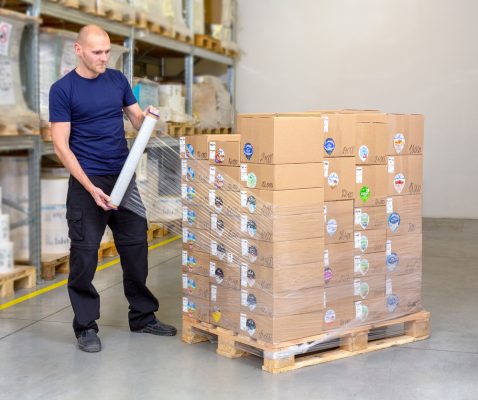Hand wrapping has dominated the packaging industry for decades. But with advances in technology, it’s made automatic and semi-automatic pallet wrapping machines the go-to choice for producers, both big and small.

Let’s look at the options you have for pallet wrapping:
Manual Stretch Wrapping
This requires people to stretch wrap a load manually. A member of your team secures the film to the pallet, after which they walk the film around the load. It’s a physically demanding process that can cause health concerns in a warehouse’s environment, which are notoriously hot. Other downsides are that this method has higher material costs because there is no consistency of film usage and no pre-stretch.
Semi-Automatic Stretch Wrapper
Semi-automatic and automatic pallet stretch wrapping machines are either a turntable or straddle style. It works by loading the item on or in the stretch wrapper’s wrap zone. The stretch film is then applied.
- Turntable models – rotate the load on a turntable.
- Straddle style models – have a wrapped arm that moves around the load to apply the film. No rotation of the load is required. Best used for heavy, extremely light, or unstable loads.
High-Speed Automatic Stretch Wrappers
Similar to semi-automatic styles, a machine performs the stretch wrapping of a load. They usually include infeed and exit conveyors, which automatically cycle loads through the machine.
Customization
Various features can be added to semi-automatic machines:
- automatic cutting and clamping of film
- remote start lanyard allowing fork truck operators to remain buckled in their seats on the trucks even while wrapping loads
Whatever the size of your business venture, the impact on efficiency and productivity offered by switching to a pallet wrapping machine will undeniably make the investment worthwhile. Not convinced? Let’s look at how the two compare:
Productivity
Manual hand wrapping:
No matter how fast your production line is churning out finished goods ready to be palletized, if you have to rely on workers at the end of the production line, you’re wasting time. Manual wrapping is not efficient for higher volume manufacturers.
Pallet wrapping machines:
Upgrading to a semi-automatic pallet wrapper could double the productivity of your end-of-line packaging. Imagine cutting down the time your team takes to wrapping a pallet to two minutes.
Protection
Manual hand wrapping:
Hand wrapping won’t offer the same protection to products as an individual cannot achieve an automated pallet wrapping machine’s consistency and tightness. There is also the factor of human error that leads to unevenly balanced loads. Research has shown that manually wrapping pallets puts your employees at risk for musculoskeletal disorders (MSDs). The potential for work-related injuries is also higher.
Pallet wrapping machines:
Not only will you enjoy more secure loads, but you’ll also save time because your teams won’t have to double-check pallet containment before loading each pallet into trucks for shipping. An automated machine will improve consistent wrapping, require less film usage, and a lower risk of a work-related injury.
Quality
Manual hand wrapping:
It’s untrue that packing by hand is better because you can monitor the sturdiness of the packing. In fact, they are less likely to be accurate or precise compared to automatic wrappers. They won’t be able to ensure all the angles are consistent, so clients won’t receive their goods looking neat and secure.
Pallet wrapping machines:
They are designed to secure goods with accuracy and precision. When the pallets are wrapped, they all look the same.
Wastage
Manual hand wrapping:
Wrapping by hand can never maximize the amount of stretch that is achieved.
Pallet wrapping machines:
Because there is more wrap potential with automated pallet wrapping machinery, you can reduce the amount of film waste. Savings could amount to as much as 60 percent, plus the savings you’ll achieve on more reliable load containment and higher pre-stretch. When you look at the numbers, it makes sense to switch.
Costs
Manual hand wrapping:
You need hands to do this work, which translates into labor costs. There’s no avoiding this.
Pallet wrapping machines:
Investing in a semi-automatic pallet wrapper will cut the time needed to wrap a pallet in half. Think of the labour saving costs. You will also reduce the number of materials used to wrap pallets. Machines use the precise amount of film and stretch the film to its fullest potential.
Another benefit is you won’t lose profits due to damaged product and losses because you will no longer have products falling off pallets. Machines guarantee items are shipped in a sturdy and stable pallet.
Inventory control
Manual hand wrapping:
You’ll achieve the benefits of tacking similar products together. Manual wrapping makes inventorying easier and reduces the chances of product separation that wastes time. However, you won’t achieve clear and consistent stretch wraps.
Pallet wrapping machines:
Because of the consistency with wrapping, you can scan straight through the material if you are using a scanning system and are doing inventory.
Interesting Related Article: “How Product Packaging Impacts Your Business“

